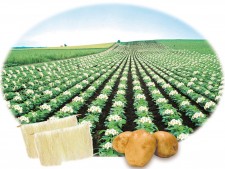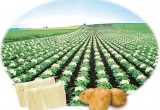
Guangzhou, China, July 14, 2016 (Newswire.com) - The 13th Five-year Plan for the Potato Industry (2016-2020) was released recently, putting forward the development strategy, direction and focus of China’s potato industry in the next 5 years. The goal for planting area is over 6.67 million ha (100 million mu), for yield 130 million tonnes and for potato starch yield from 800,000 to 1,000,000 tonnes. CCM thinks that such action fully demonstrates China’s determination to promote the potato as staple food, and takes a positive attitude to the popularization of potato in China.
The 13th Five-year Plan has mentioned that over 30% of potato will be consumed as staple food in 2020. At that time, the increment of food demand in China might reach more than 50 billion kilograms. However, due to the restraint of cultivated land resource and planting efficiency, the space for production increase of wheat and rice will be diminished.
What’s more, in 2016, China officially cancels the purchase policy of corn for temporary storage and needs to reduce the huge corn inventories (more than 250 million tonnes, as of 31 April, 2016). Therefore, cutting down the corn planting area will be the mainstream in China.
Why potato could be the 4th staple food in China besides rice, wheat and corn? CCM thinks that the main reasons are its high nutrition value and good adaptiveness for planting environment.
The development of potato as staple food can meet people’s demand for the improvement of dietary pattern. Potato is rich in dietary fiber and low in fat content. Its nutrition is more all-round and balanced with 18 amino acids, a lot of cellulose and microelement that human body needs. Xie Conghua, the professor of Huazhong Agricultural University and the research expert in potato, states that promoting potato as staple food is conducive to China’s food security and people’s healthy diet.
The staple food is required to be produced at a big scale in large areas. Fortunately, potato is qualified with great adaptiveness in dry, cold or barren areas. Also, its planting needs less water and fertilizers, with water use efficiency higher than that of wheat and rice. Jin liping, the chief scientist of China’s potato industry technology system, analyzes that the minimal water demand for potato’s growing is only 350mm, while that of wheat and rice are 450mm and 500mm, respectively. In the arid and semi-arid regions in Northwest China, it’s difficult for cereal to germinate. However, the potato not only can grow regularly with per unit area yield much higher than that of wheat and rice, but also lessens water loss and soil erosion.
Besides, CCM thinks that under the impact of genetically modified and hybrid technology and from the perspective of state food security, potato, as a purely natural crop, enjoys the advantage of easy planting, less water demand and high use ratio of land, which is another reason to become the 4th staple food.
Though there is huge potential for potato as staple food, CCM thinks that it still faces a lot of challenges.
In Europe and the US, potato is already staple food, so the investment of science and research on it is relatively larger and its technology has been advanced in the world. Yearly consumption of potato per capita in European countries is 50kg to 60kg and that in Russia can be 170kg or so.
However, as for China’s potato production and consumption, its growth is not fast, production level not high and the development uneven. Firstly, China is shortage of fine breeds of potato, and the seed potato that is fit for processing to potato granules & flakes is few and instable. Besides, the mechanization of potato production is obviously low with processing industry chain unformed, compared with that of other staple foods.
Actually, the traditional extensive planting prevails in most of the regions in China all the time. Currently, the potato planting area in China is 5.33 million ha (80 million mu), among which more than 4.67 million ha (70 million mu) is low yield for a long time. In addition, 75% of potato in China is produced in mountain areas and hillside fields, where the small-size machinery is needed. However, China is lack of small-size machinery and is dependent on import for big-size one. In spite of it, the policy support to potato is much weaker than that to other staple foods like wheat and rice, so it needs to be improved in time.
The experts and entrepreneurs in potato industry express that though faced lots of challenges, it’s absolutely a piece of good news to promote the potato as staple food and its industry development in China, which will drive the huge and potential progress in potato deep-level industry market.
On 23 Feb, 2016, the Ministry of Agriculture of the People's Republic of China (MOA) issued the Guidance of Boosting the Development of Potato Industry to vigorously advance the development of traditional popular staple food like noodles and rice noodles. Meantime, the country will actively promote the development of snack and functional staple food like chips and crisps. Therefore, some terminal products will enjoy huge potential in the future. And the opportunity for potato processing industry can be seen in some goals comparison between 13th Five-year Plan and 12th Five-year Plan for potato industry in China.
Professor Xie suggests that if we want to develop potato as staple food, it’s necessary to provide it with state treatment for national food so as to enhance farmer’s positivity. At the same time, the research of the whole potato industry chain collaboration should be intensified, including the increasing investment for research, the acceleration of seed breeding as staple food, the advancement of scale and machinery.
In addition, CCM thinks that the process of potato as staple food will benefit from the big change of China’s agricultural planting structure. For example, the MOA issued the Guidance of Structure Adjustment Plan on Corn Planting Area in Sickle-shape Region, planning to reduce corn area by over 3.33 million ha (50 million mu) by 2020. Besides, the planting area and output of soybean in China shrank further in 2015, with output decreasing to 11 million tonnes or so, a bottom in the past 22 years.
Free download of CCM Newsletter of China Food Industries.
IFT (the Institute of Food Technologists )
The IFT16 will be held in Chicago on 16-19 July. This is where the latest global food trends are on display. You can discover the food industry’s largest and latest information. CCM will also attend the expo, and welcome to discuss with us about China’s food industry at Booth #4921.
If you are interested in more information about food in China, including sweeteners, amino acids, corn, vitamin and other food industries, just come and discuss with us.
More related information in CCM’s Online Platform
If you want to know more about information about potato, or agriculture, you can enter our Online Platform for it.
It mainly concludes:
- Newsletters: You to catch the latest news about agriculture industry, including the Suppliers, traders, consumers, price, export, import and government policies and so on.
- Report: You can get comprehensive and in-depth analysis towards the crops, or other processing products and competitive products
- Company profile: You can get the detailed information of public and private Chinese companies within the industry.
BOON: Now you can enjoy the free trial in the Online Platform for 7 days. If needed, welcome to contact us directly by emailing emarket23@cnchemicals.com or calling +86-20-3761 6606.
Source: CCM, CCM Online Platform
Share:




